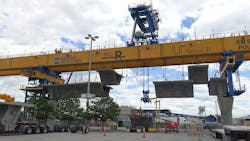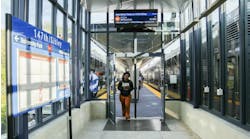REM utilizes "launching gantries" to construct light-rail elevated structure
Réseau express métropolitain (REM) is employing an unusual method to construct the 14.5 km (approximately 9 miles) of elevated structure for future light-rail trains to travel over in Greater Montreal. Two launching gantries – enormous yellow machines – are assembling the prefabricated sections of the structure piece-by-piece.
The machines are 105 meters (344.48 feet) long and can support 550 tons, which will come in handy as each concrete segment weighs between 42.3 and 57.7 tons. REM explains the beams raise the prefabricated segments and slide them up against one another to form the deck on when the REM’s rail cars will run.
"That’s why they're called 'launching gantries' – because the prefabricated segments are 'launched' one after the other," said REM.
There are several advantages REM lists to utilizing launching gantries such as limiting the amount of work performed at heights, the quality of the structure built is increased due to prefabrication, there is a decreased impact on road traffic, the repetitive process requires minimal workers and equipment and the construction speed is increased with this method.
"It’s quite an impressive construction method and ensures things to move forward very quickly. On average, it takes two days to erect one span, that is, to cover the distance between two columns (30 to 40 metres)," explained REM. "Once the span is complete, the beam is moved forward to the next two columns, and the process is repeated. It will take [the two gantries] three years to build the entire 14.5-km section of elevated structure."
The two launching gantries have been named Marie and Anne. The first launching gantry, Marie after Marie Curie Street in the Technoparc, will assemble the elevated structure between the Technoparc and the midway point, Fairview Pointe-Claire. From that midway point, the second launching gantry, Anne, will build the remaining section of elevated structure, up to Sainte-Anne-de-Bellevue, which is where the machine gets its nickname.

Mischa Wanek-Libman | Group Editorial Director
Mischa Wanek-Libman is director of communications with Transdev North America. She has more than 20 years of experience working in the transportation industry covering construction projects, engineering challenges, transit and rail operations and best practices.
Wanek-Libman has held top editorial positions at freight rail and public transportation business-to-business publications including as editor-in-chief and editorial director of Mass Transit from 2018-2024. She has been recognized for editorial excellence through her individual work, as well as for collaborative content.
She is an active member of the American Public Transportation Association's Marketing and Communications Committee and served 14 years as a Board Observer on the National Railroad Construction and Maintenance Association (NRC) Board of Directors.
She is a graduate of Drake University in Des Moines, Iowa, where she earned a Bachelor of Arts degree in Journalism and Mass Communication.


